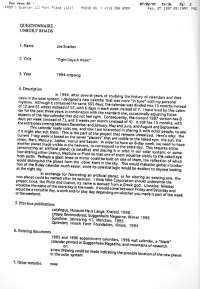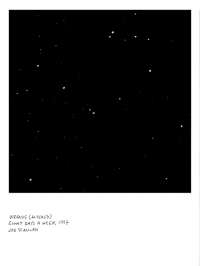In 1994, after several years of studying the history of calendars and their basis in the solar system, I designed a new calendar that was more "in tune" with my personal rhythms. Although it contained the same 365 days, the calendar was divided into 15 Instead of 12 and 61 weeks instead of 52, with 6 days in each week instead of 7. I have lived by this calendar for the past three years in combination with the standard one, occasionally adjusting those aspects of the new calendar that did not feel right. Consequently, the current 1997 version has 8 days per week (instead of 7), and 3 weeks per month (instead of 4). It still has l5 months, with the extra ones coming between December and January, May and June, and August and September.
This calendar really suits me, and now I am interested in sharing it with other people, to see it it might also suit them. This is the part of the project that remains unrealized. Here's why: the current 7-day week is based on the seven "planets" that are visible to the naked eye: the sun, the moon, Mars, Mercury, Jupiter, venus and Saturn. In order to have an 8-day week, we need to have another planet made visible In the heavens, to correspond to the extra day. This requires either constructing an artificial planet (a satellite) and placing it in orbit in our solar system; or some how altering either Uranus, Neptune or Pluto so that one of them would be visible to the naked eye from earth. Perhaps a giant lense or mirror could be built on one of them, the reflection of which would distinguish the planet from the other stars in the sky. This would make the global introduction of the 8-day calendar much easier, since its celestial logic would be evident to anyone looking at the night sky.
In exchange for fabricating an artificial planet, or for altering an existing one, the new planet could be named after its sponsor. I think Nike Corporation should underwrite the project since, like Pluto and Uranus, its name is derived from a Greek god. Likewise, Nikeday would be the name of the extra day in the week. It would come between Friday and Saturday and would be a versatile day, a work and/or play day depending on whether you made it part of the week or the weekend.
Previous publications:
catalogue, Museum Haus Lange, Krefeld, 1996 Utopia Reconsidered, Guggenheim Magazine, Winter 1996 Sunshine, Jahresring 41, MOnchen, 1995 Optimism, Hirsch Farm Foundation, Illinois, 1994
Existing documents:
1995 and 1996 appointment calendars, 1996 wall calendar, a ''blank'' calendar printed in Guggenheim Magazine, and mountains of research
or:
a new drawing could be made indicating the possible location of the new planet in the solar system
In 1994, after several years of studying the history of calendars and their basis in the solar system, I designed a new calendar that was more "in tune" with my personal rhythms. Although it contained the same 365 days, the calendar was divided into 15 Instead of 12 and 61 weeks instead of 52, with 6 days in each week instead of 7. I have lived by this calendar for the past three years in combination with the standard one, occasionally adjusting those aspects of the new calendar that did not feel right. Consequently, the current 1997 version has 8 days per week (instead of 7), and 3 weeks per month (instead of 4). It still has l5 months, with the extra ones coming between December and January, May and June, and August and September.
This calendar really suits me, and now I am interested in sharing it with other people, to see it it might also suit them. This is the part of the project that remains unrealized. Here's why: the current 7-day week is based on the seven "planets" that are visible to the naked eye: the sun, the moon, Mars, Mercury, Jupiter, venus and Saturn. In order to have an 8-day week, we need to have another planet made visible In the heavens, to correspond to the extra day. This requires either constructing an artificial planet (a satellite) and placing it in orbit in our solar system; or some how altering either Uranus, Neptune or Pluto so that one of them would be visible to the naked eye from earth. Perhaps a giant lense or mirror could be built on one of them, the reflection of which would distinguish the planet from the other stars in the sky. This would make the global introduction of the 8-day calendar much easier, since its celestial logic would be evident to anyone looking at the night sky.
In exchange for fabricating an artificial planet, or for altering an existing one, the new planet could be named after its sponsor. I think Nike Corporation should underwrite the project since, like Pluto and Uranus, its name is derived from a Greek god. Likewise, Nikeday would be the name of the extra day in the week. It would come between Friday and Saturday and would be a versatile day, a work and/or play day depending on whether you made it part of the week or the weekend.
Previous publications:
catalogue, Museum Haus Lange, Krefeld, 1996 Utopia Reconsidered, Guggenheim Magazine, Winter 1996 Sunshine, Jahresring 41, MOnchen, 1995 Optimism, Hirsch Farm Foundation, Illinois, 1994
Existing documents:
1995 and 1996 appointment calendars, 1996 wall calendar, a ''blank'' calendar printed in Guggenheim Magazine, and mountains of research
or:
a new drawing could be made indicating the possible location of the new planet in the solar system

